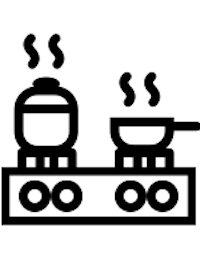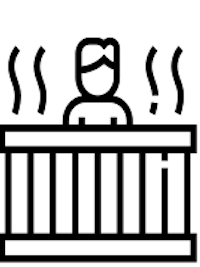The house has a 40A supply which is plenty adequate. Monthly bills come to around ¥4,000, ±$40. The cabin's electricity comes from a solar panel connected to a 12v battery, which is in turn connected to an inverter which provides standard household electricity at 100v

The graphic is a little misleading as there is no air conditioning in the house or cabin. We get by with fans during the summer. It's not bad as given our altitude and seaside location, there is usually a cooling breeze to be had. There are all wall dehumidifiers that come on automatically in summer when humidity levels exceed the cut off. In winter heating is provided by kerosene heaters. Kerosene can be purchased from any of the filling stations. The cabin is heated by a standalone kerosene heater than does not use electricity.

The water supply is regular piped water; however, the municipal supply runs to the bottom of the hill. It is then pumped up hill to a tank located some meters above this house. All of the 'active' houses on the hill pay a collective water bill for the water used and the electricity needed to pump the water uphill. The amount each household pays is a straight division of the total amount by the number of households.


Hot water for showers and washing is powered by gas. The stove/cooker is also gas powered. There are tanks outside the house and a service company maintains them and bills monthly. Bills average ¥4,000 ± $40
The house has a 40A supply which is plenty adequate. Monthly bills come to around ¥4,000, ±$40. The cabin's electricity comes from a solar panel connected to a 12v battery, which is in turn connected to an inverter which provides standard household electricity at 100v

The graphic is a little misleading as there is no air conditioning in the house or cabin. We get by with fans during the summer. It's not bad as given our altitude and seaside location, there is usually a cooling breeze to be had. There are all wall dehumidifiers that come on automatically in summer when humidity levels exceed the cut off. In winter heating is provided by kerosene heaters. Kerosene can be purchased from any of the filling stations. There are no regular heating or cooling bills. The power consumption for fans and kerosene heaters (they use electricity to drive dispersal fans), and dehumidifiers will be captured in the electricity bill. The cabin is heated by a standalone kerosene heater than does not use electricity. There is fan for summertime.

The water supply is regular piped water; however, the municipal supply runs to the bottom of the hill. It is then pumped up hill to a tank located some meters above this house. All of the 'active' houses on the hill pay a collective water bill for the water used and the electricity needed to pump the water uphill. The amount each household pays is a straight division of the total amount by the number of households.


Hot water for showers and washing is powered by gas. The stove/cooker is also gas powered. There are tanks outside the house and a service company maintains them and bills monthly. Bills average ¥4,000 ± $40
The house has a 40A supply which is plenty adequate. Monthly bills come to around ¥4,000, ±$40. The cabin's electricity comes from a solar panel connected to a 12v battery, which is in turn connected to an inverter which provides standard household electricity at 100v

The graphic is a little misleading as there is no air conditioning in the house or cabin. We get by with fans during the summer. It's not bad as given our altitude and seaside location, there is usually a cooling breeze to be had. There are all wall dehumidifiers that come on automatically in summer when humidity levels exceed the cut off. In winter heating is provided by kerosene heaters. Kerosene can be purchased from any of the filling stations. There are no regular heating or cooling bills. The power consumption for fans and kerosene heaters (they use electricity to drive dispersal fans), and dehumidifiers will be captured in the electricity bill. The cabin is heated by a standalone kerosene heater than does not use electricity. There is fan for summertime.

The water supply is regular piped water; however, the municipal supply runs to the bottom of the hill. It is then pumped up hill to a tank located some meters above this house. All of the 'active' houses on the hill pay a collective water bill for the water used and the electricity needed to pump the water uphill. The amount each household pays is a straight division of the total amount by the number of households.


Hot water for showers and washing is powered by gas. The stove/cooker is also gas powered. There are tanks outside the house and a service company maintains them and bills monthly. Bills average ¥4,000 ± $40